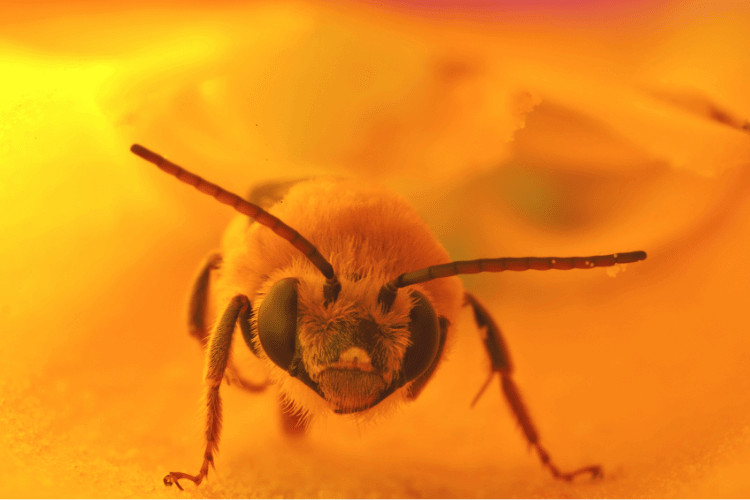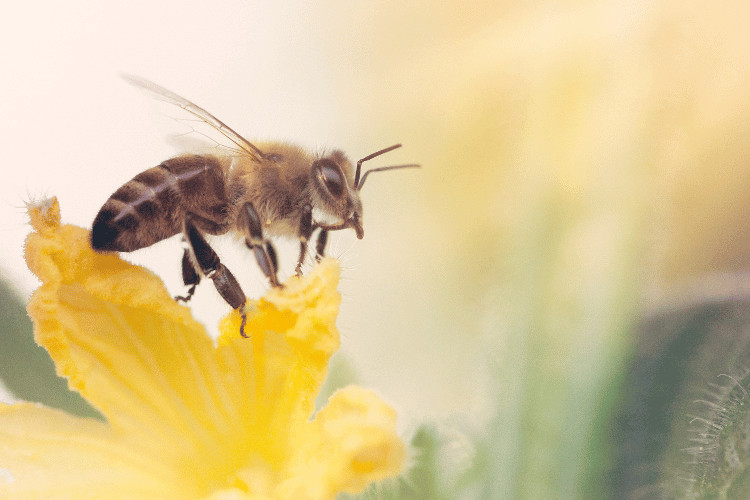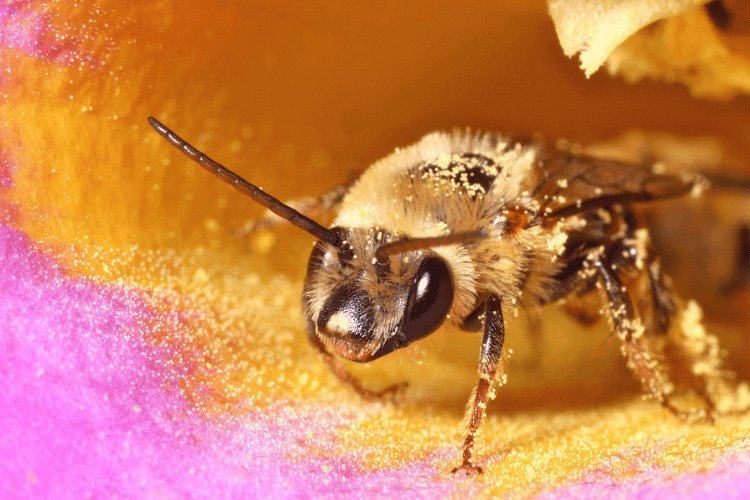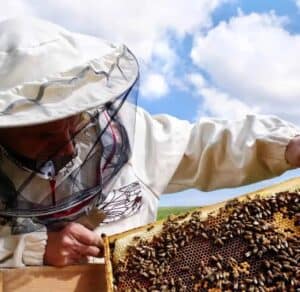Squash Bees: A Complete Guide
Squash bees are medium-sized bees that serve an important role in pollinating cucurbit crops. They do so using their thick hairs that serve as one of their identifying features.
But do they make honey? What’s their use to the ecosystem, and why are they named squash bees?
Let’s find out.
Description and Characteristics of Squash Bees

Squash bees (Peponapis pruinosa) stand as unsung heroes in the realm of pollinators, playing a vital role in the reproductive success of cucurbit crops.
These native insects are specialized pollinators, intricately adapted to the flowers of pumpkins, gourds, and squashes. They rely on squash pollen to feed their young so much that they acquired the name “squash bees”
Characteristics
- Cucurbit Specialists: Squash bees are renowned for their specialization in cucurbit pollination. Their strong coevolution with these crops has resulted in an intricate relationship that benefits both bees and plants.
- Medium-Sized Insects: With an average size of less than an inch, squash bees fall within the medium range among pollinators. This moderate size plays a role in their effectiveness as pollinators.
- Dense Hairs: Their bodies are adorned with dense hairs, enhancing their efficiency in collecting pollen from cucurbit flowers.
- Strong Hind Legs: Squash bees possess strong hind legs, designed to carry and transport ample amounts of pollen from flower to flower.
- Distinctive Appearance: Their appearance distinguishes them from other bees, showcasing their unique role in cucurbit pollination.
- Solitary Nesters: Unlike social honeybees, squash bees are solitary nesters. They construct their nests individually, often within the soil near cucurbit crops.
- Spring Emergence: As the temperatures warm in spring, squash bees emerge from their underground nests to initiate their crucial pollination role.
What Is the Purpose of Squash Bees
The primary purpose of squash bees is to pollinate cucurbit crops. They do this by transferring pollen from the male anthers to the female stigmas of the flowers. This process is essential for the production of fruit.
Squash bees are important pollinators because they are efficient at transferring pollen. They are also active early in the morning, before other pollinators, such as honeybees, are awake. This makes them especially important for pollinating cucurbit crops that bloom early in the season.
In addition to pollinating cucurbit crops, squash bees also help to pollinate other plants (we’ll list them soon). They are also important pollinators of wildflowers and other native plants.
Squash Bees: Habitat and Foraging Preferences
Squash bees are experts at thriving within the specific habitats that support their specialized role. They are commonly found in gardens and agricultural fields where cucurbit crops like pumpkins, gourds, and squashes flourish.
These cultivated environments provide the ideal setting for squash bees to carry out their essential pollination activities.
These native pollinators meticulously collect pollen using their specialized body features, like dense hairs and strong hind legs, optimizing their efficiency as they traverse from one flower to another.
Squash bees are active from early spring to late summer. The females dig nesting holes in the ground, and they provision each cell with pollen and nectar. The larvae hatch from the eggs and feed on the pollen and nectar. The adults emerge from the cells in the fall.
Here are some of the factors that affect the habitat and foraging preferences of squash bees:
- Climate: Squash bees prefer warm, sunny climates. They are not able to survive in cold climates.
- Soil type: Squash bees prefer sandy or well-drained soils. They are not able to nest in clay or compacted soils.
- Plant availability: Squash bees are attracted to cucurbit plants, but they will also visit other flowers. They need a variety of flowers available to them to forage successfully.
Where Can You Find Squash Bees?
Squash bees are found in North America, Europe, and Asia. They are most common in warm, sunny climates.
Squash bees are solitary bees, which means that they do not live in colonies like honeybees. They are also ground-nesters, which means that they dig their nests in the ground.

Here are some of the places where you can find squash bees:
- Meadows
- Fields
- Gardens
- Forests
- Sandy or well-drained soils
- Near cucurbit plants
- Near flowers
Squash Bees Life Cycle, Mating, and Nesting
The life cycle of squash bees is a captivating journey of adaptation and survival.
Life Cycle
Squash bees follow a cycle that aligns with the flowering seasons of cucurbit crops. Adult bees emerge from their underground nests in the spring, ready to engage in their critical pollination activities.
As specialists in cucurbit pollination, these bees are strategically synchronized with the bloom period of their preferred flowers.
Mating
Mating rituals are a fundamental aspect of the squash bee’s life cycle. Adult male and female squash bees engage in courtship behaviors, ensuring successful reproduction.
Once mated, female bees set out on their mission to locate suitable nesting sites for the continuation of their species.
Nesting
Squash bees exhibit unique nesting behaviors that contribute to their survival strategy. Unlike social bees that live in colonies, squash bees are solitary nesters. Female bees excavate small burrows in the ground, creating individual nest cells.
These cells serve as safe havens for their offspring. Within each cell, the female places a mixture of nectar and pollen, providing sustenance for the developing larva.
Importance of Squash Bees in Ecosystems and Agriculture
Here are some of the reasons why squash bees are important to ecosystems and agriculture:
- They pollinate a variety of plants, including cucurbit crops, tomatoes, cucumbers, melons, wildflowers, and other native plants.
- They help to ensure that these plants are pollinated and that they can produce fruit.
- They play a role in the food chain, providing food for other animals, such as birds and bats.
- They help to maintain healthy ecosystems by pollinating plants and helping to disperse seeds.
- They contribute to agricultural production, helping to ensure that farmers have a bountiful harvest.
Common Questions About Squash Bees
What Do Squash Bees Eat?
Adult squash bees do not eat pollen or nectar. They are solitary bees, which means that they do not live in colonies or produce honey like honeybees. They also do not have a hive to store food. Instead, adult squash bees get the energy they need from the fat reserves they build up as larvae.
The larvae of squash bees, on the other hand, do eat pollen and nectar. The female squash bee provisions each cell of her nest with pollen and nectar, which the larvae feed on. The pollen and nectar provide the larvae with the nutrients they need to grow and develop.
Here are some of the flowers that squash bees visit for food:
- Cucurbit plants, such as squash, pumpkins, and gourds
- Clover
- Dandelions
- Sunflowers
- Blackberries
- Raspberries
- Wildflowers
- Other native plants
Are Squash Bees Dangerous?
Squash bees are more focused on their foraging and pollination activities than on interacting with humans. They are not known for stinging unless they are directly provoked or mishandled. Their primary purpose is to facilitate the reproduction of cucurbit plants by transferring pollen from flower to flower.
While the risk of being stung by squash bees is minimal, it’s always wise to exercise caution around any bee species. If you encounter squash bees while working in a garden or agricultural setting, it’s advisable to remain calm and avoid swatting or disturbing them.
By respecting their space and role in the ecosystem, you can coexist harmoniously with these essential pollinators and contribute to the health of local ecosystems and crop production.

What Size Are Squash Bees?
Squash bees are about 0.5 inches (1.3 centimeters) long. They are slightly larger than honeybees and have black bodies with yellow markings. The females have a long, pointed abdomen that they use to dig nesting holes. The males have shorter abdomens.
How to Identify Squash Bees?
Here are some of the key features that can help you identify resin bees:
- Medium-sized bees: Resin bees are medium-sized bees, typically ranging in length from 5 to 15 millimeters (0.2 to 0.6 inches).
- Black or dark brown body: Resin bees are black or dark brown, with some species having yellow or orange markings.
- Long, pointed abdomen: The females have a long, pointed abdomen that they use to collect resin.
- Resin-covered bodies: Resin bees often have their bodies covered in resin, which they collect from plants.
- Nests made of resin: Resin bees build their nests out of resin, which they collect from plants.
How to Attract Squash Bees
Plant a variety of flowers that produce nectar and pollen. Resin bees are attracted to a variety of flowers, including:
- Yarrow
- Goldenrod
- Black-eyed Susan
- Coneflower
- Aster
- Echinacea
- Sunflowers
- Clover
- Dandelions
- Lavender
- Mint
Provide nesting sites for resin bees. Resin bees build their nests in holes in trees or other wood. You can provide nesting sites for resin bees by leaving some dead wood in your garden or by creating a bee hotel.
Water your garden regularly. Resin bees need water to survive. Also, keep your garden free of weeds. Weeds can compete with flowers for nectar and pollen.
The Verdict
Squash bees look fairly similar to honey bees, but their color pattern is different and they don’t produce honey. They are also solitary bees, so don’t go looking for them in beehives.
If you want to attract them to your garden, make sure you follow the instructions mentioned above. Just keep a fair distance to avoid harming yourself or the bees.

Joseph Davis
My goal is to show that anyone can take up beekeeping and it can be a very rewarding hobby. I strive to share my experiences and answer any questions you may have.
